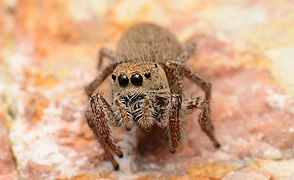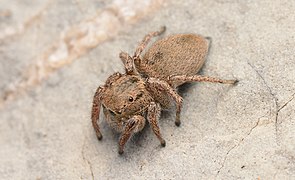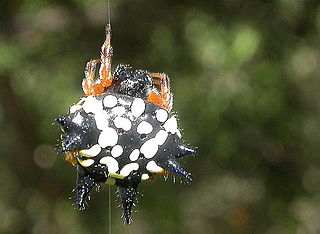
Austracantha is a genus of spider with a single species, Austracantha minax, commonly known as the jewel spider or the Christmas spider. It is a member of the family Araneidae and is endemic to Australia. They are relatively small spiders, reaching a maximum total body length of only around 12 mm (0.47 in) for females, and 5 mm (0.20 in) for males. Their abdomen has six distinctive projections ("spines") that makes them easy to identify. They are predominantly a shiny black, with variable white, yellow, and orange patterns. Melanistic forms also occur during autumn. They are facultatively gregarious, and can be found in large aggregations of overlapping orb webs. They feed on small flying insects that get entangled in their webs. They are harmless to humans, though the webs can be a nuisance for bushwalkers. They are most abundant during the summer months.

Havaika is a genus of the spider family Salticidae. The genera Habronattus and Pellenes are closely related. All then known species were split from the genus Sandalodes.

Araniella cucurbitina, sometimes called the "cucumber green spider", is a spider of the family Araneidae. Araniella Cucurbitina is found across Europe, Western Asia, Central Asia and Japan. The “cucurbitina” in Araniella Cucurbitina comes from the word “cucurbit” which is a family of plants including cucumbers.

Hasarius adansoni, known commonly as Adanson's house jumper, is a species of jumping spider that is common in warm regions around the world, often associated with people.

Porrhothele antipodiana, the black tunnelweb spider, is a spider found throughout much of New Zealand and the Chatham Islands in bush and gardens and is one of New Zealand's most researched spiders. It is related to tarantulas, and is a harmless relative of the venomous Australian funnel-web spider.

Zygoballus sexpunctatus is a species of jumping spider which occurs in the southeastern United States where it can be found in a variety of grassy habitats. Adult spiders measure between 3 and 4.5 mm in length. The cephalothorax and abdomen are bronze to black in color, with reddish brown or yellowish legs. The male has distinctive enlarged chelicerae and front femora. Like many jumping spiders, Z. sexpunctatus males exhibit ritualized courtship and agonistic behavior.

Habronattus viridipes is a species of jumping spider that can be found in the eastern United States and southern Canada.
Habronattus fallax is a species of spiders from the family Salticidae found in the United States and Mexico.

Habronattus coecatus is a species of jumping spider that can be found in Mexico, the United States, and Bermuda.

Habronattus americanus is a species of jumping spiders from the family Salticidae.
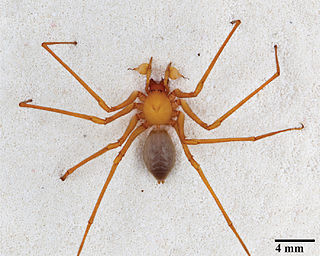
Trogloraptor is a genus of large spiders found in the caves of southwestern Oregon. It is the sole genus in the family Trogloraptoridae, and includes only one species, Trogloraptor marchingtoni. These spiders are predominantly yellow-brown in color with a maximum leg span of 3 in (7.6 cm). They are remarkable for having hook-like claws on the raptorial last segments of their legs.
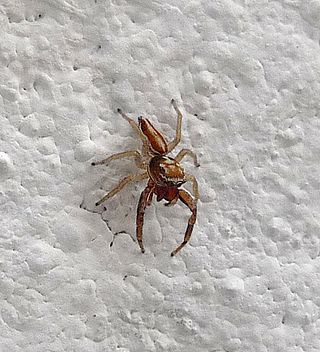
Icius mbitaensis is a species of jumping spider in the genus Icius that lives in Kenya. It was first described in 2011 by Wanda Wesołowska. The spider lives communally amongst other spiders and preys on insects. It is small, with a cephalothorax between 2.0 and 2.2 mm long and an abdomen 2.2 and 2.7 mm long. The female and male are similar in size and colouration of the carapace. The male abdomen is grey-brown with a faint pattern visible on some specimens. The female has a brown abdomen, sometimes more reddish-brown to the front, with some examples having a patch in the middle and spots to the back. The species is similar to other Icius spiders but differs in the size of the embolus and tibial apophysis of the male and the epigynal depression and pockets, seminal ducts and spermathecae of the female.

Aelurillus desertus is a species of jumping spider in the genus Aelurillus that is endemic to the United Arab Emirates. It was first described in 2010 by Wanda Wesołowska and Antonius van Harten. Initially only the male was described, the female following ten years later. The spider was originally classified in the genus Rafalus but was moved to its current genus at the same time as the female description was first published. The species is medium-sized with cephalothorax that is between 2.8 and 3.3 mm long and a abdomen that is between 2.8 and 4.8 mm long. The female is larger than the male. The carapace has a distinctive stripe. The female has three darker spots on the abdomen. The species can be distinguished by the existence of a triangular lobe on the palpal bulb on the male and the way that the copulatory openings are close to the rear of the epigyne on the female.
Bacelarella gibbosa is a species of jumping spider in the genus Bacelarella that is endemic to Nigeria. The spider has a distinctive shape to the carapace that gives the species its name, which can be translated hunchback. It was first described in 2012 by Wanda Wesołowska and Glavis Edwards. The spider is medium-sized with a cephalothorax that has a length between 3.1 and 3.8 mm and an abdomen that is between 2.6 and 3.4 mm long. The female is larger than the male. It is also generally lighter in colour, the male having a darker brown carapace, clypeus and legs. The species can be distinguished from others in the species by the male's round small palpal bulb and long thin embolus and the larger pocket in the female's epigyne.

Habronattus pyrrithrix is a species of jumping spider in the family Salticidae. It is found in the southwestern United States and western Mexico.

Habronattus cognatus is a species of spider in the family Salticidae. It is found in North America.

Habronattus mataxus is a species of jumping spider found in Texas and northern Mexico.
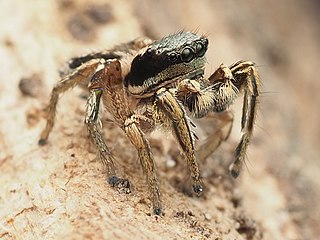
Habronattus mexicanus is a species of jumping spider in the genus Habronattus. The species was first identified in 1896 in Mexico, after which it is named, originally allocated to the genus Habrocestum. The species has subsequently been identified in locations in North and Central America, as well as islands in the Caribbean Sea. The spider is small, but displays one of the most complex sexual displays, including sophisticated vibatory song patterns.

Habronattus orbus is a species of jumping spider in the family Salticidae. It is found in the United States.

Habronattus texanus is a species of jumping spider in the family Salticidae. It is found in the United States and Mexico.


